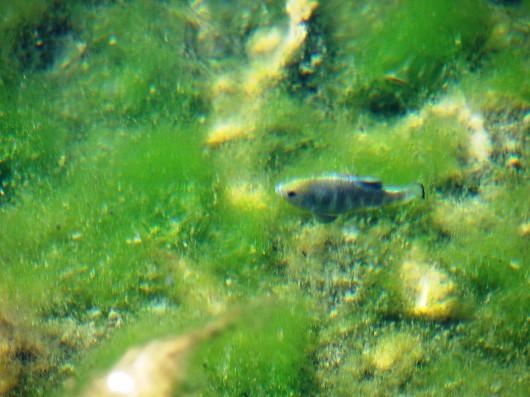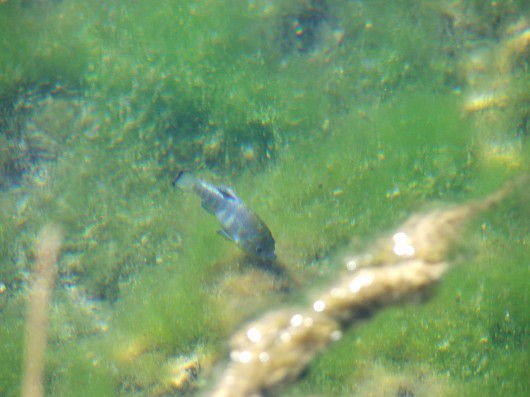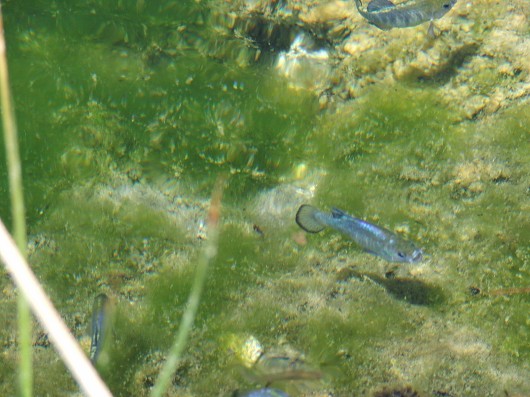Amargosa River Pupfish
-
Scientific NameCyprinodon nevadensis amargosae
-
NativeYes
-
Identification
 Amargosa pupfish, left side. Photographed at Ash Meadows, Nevada in April 2006. Photo by Joseph C. Sullivan.
Amargosa pupfish, left side. Photographed at Ash Meadows, Nevada in April 2006. Photo by Joseph C. Sullivan. Amargosa pupfish, right side. Photographed at Ash Meadows, Nevada in April 2006. Photo by Joseph C. Sullivan.
Amargosa pupfish, right side. Photographed at Ash Meadows, Nevada in April 2006. Photo by Joseph C. Sullivan. Amargosa pupfish, dorsal/frontal view. Photographed at Ash Meadows, Nevada in April 2006. Photo by Joseph C. Sullivan.
Amargosa pupfish, dorsal/frontal view. Photographed at Ash Meadows, Nevada in April 2006. Photo by Joseph C. Sullivan.PLEASE NOTE: The photos and information shown here are for Amargosa Pupfish (Cyprinodon nevadensis), of which the Amargosa River Pupfish is a sub-species.
- Small, usually less than 50 mm TL
- Blunt head, deep body (especially in reproductive males)
- Small and oblique terminal mouth, complete row of tricuspid teeth; central cusps truncated or pointed
- Large scales, spines absent from circuli; interspaces reticulated
- Pelvic fins small or absent, preopercular pores: 7-17
- Coloration:
- Breeding males: bright blue sides and causal peduncle, black band on edge of tail
- Breeding females: olive brown, ocellus usually present on posterior base of dorsal fin, 6-10 lateral vertical bars (may be faint)
- Fin rays: anal 8-11, pectoral 11-18, pelvic 0-9, caudal 14-22
- Lateral line scales: 23-28
-
Life History
Amargosa Pupfish inhabit several isolated springs and reaches of stream that are all different in relation to habitat and water quality characteristics. In Ash Meadows, Nye County, Nevada, Pupfish live in multiple springs with temperatures ranging from 21-33°C, though within each spring the annual fluctuations are only 2-7°C. The meadow springs are typically shallow ( Lining the edges of most of these springs are emergent cattails. In the saline Amargosa River, Pupfish deal with daily changes of 15-20°C and annual fluctuations from near freezing up to 40°C. In Tecopa Bore, Inyo County, Amargosa Pupfish inhabit an outflow from an artesian well that is linked to the Amargosa River. The water entering the marsh is 47.5°C and within this section Pupfish survive and favor a water temperature of 42°C. During winter months the downstream end of the marsh may reach temperatures near freezing. Downstream of Tecopa on the Amargosa River is a steep and narrow canyon. The stream is less than 2 m wide and reaches depths up to 2.5 m. The water is clear, saline, and alkaline. The TDS ranges from 1,390-3,890 ppm and the dissolved oxygen levels range from 7.3-11.6 mg/L. The canyon stretch of the Amargosa River alternates from soft mud and clay pools to gravel and sand filled runs. The shores are often lined with vegetation. The Amargosa River eventually flows into Death Valley where the soft substrate is made up of small (silt, clay, sand) particles and where algae and cyanobacteria are present. The water here has a salinity ranging from 3-18 ppt depending upon the season. Water temperatures vary from 10-38°C annually though they may drop to near zero in severe winters. Another place with interesting pupfish habitat is Saratoga Springs. Pupfish inhabit the large spring pool as well as the series of lakes connected to the spring. Pupfish in the lakes favor habitat with adequate aquatic vegetation and favor water temperatures in the range of 20-30°C. Amargosa Pupfish in the Saratoga Springs drainage avoid water where the temperature exceeds 38°C and in cool months the Pupfish bury themselves in the substrate. Amargosa Pupfish are diurnal feeders with a diet composed of mostly algae and cyanobacteria. They may also feed on small invertebrates such as chironomid larvae, ostracods, copepods, and mosquito larvae. Generally they grow rapidly, though growth rates decrease in rapidly fluctuating environments. They rarely live longer than a year, and most Pupfish reach sexual maturity and a length of 25-30 mm TL in several months. Spawning by Amargosa Pupfish varies among locations. In spring environments Amargosa Pupfish have similar behavior to Owens Pupfish in that males defend territories and go through a courtship ritual with females. In the Amargosa River, spawning occurs in groups with males targeting a female among the crowd.
-
Links to Other ResearchN / A


